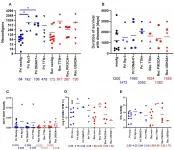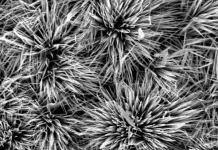(Press-News.org) Information on individuals' mobility--where they go as measured by their smartphones--has been used widely in devising and evaluating ways to respond to COVID-19, including how to target public health resources. Yet little attention has been paid to how reliable these data are and what sorts of demographic bias they possess. A new study tested the reliability and bias of widely used mobility data, finding that older and non-White voters are less likely to be captured by these data. Allocating public health resources based on such information could cause disproportionate harms to high-risk elderly and minority groups.
The study, by researchers at Carnegie Mellon University (CMU) and Stanford University, appears in the Proceedings of the ACM Conference on Fairness, Accountability, and Transparency, a publication of the Association for Computing Machinery.
"Older age is a major risk factor for COVID-19-related mortality, and African-American, Native-American, and Latinx communities bear a disproportionately high burden of COVID-19 cases and deaths," explains Amanda Coston, a doctoral student at CMU's Heinz College and Machine Learning Department, who led the study as a summer research fellow at Stanford University's Regulation, Evaluation, and Governance Lab. "If these demographic groups are not well represented in data that are used to inform policymaking, we risk enacting policies that fail to help those at greatest risk and further exacerbating serious disparities in the health care response to the pandemic."
During the COVID-19 pandemic, mobility data have been used to analyze the effectiveness of social distancing policies, illustrate how people's travel affects transmission of the virus, and probe how different sectors of the economy have been affected by social distancing. Yet despite the high-stakes settings in which this information has been used, independent assessments of the data's reliability are lacking.
In this study, the first independent audit of demographic bias of a smartphone-based mobility dataset used in the response to COVID-19, researchers assessed the validity of SafeGraph data. This widely used mobility dataset contains information from approximately 47 million mobile devices in the United States. The data come from mobile applications, such as navigation, weather, and social media apps, where users have opted in to location tracking.
When COVID-19 began, SafeGraph released much of its data for free as part of the COVID-19 Data Consortium to enable researchers, nonprofits, and governments to gain insight and inform responses. As a result, SafeGraph's mobility data have been used widely in pandemic research, including by the Centers for Disease Control and Prevention, and to inform public health orders and guidelines issued by governors' offices, large cities, and counties. Researchers in this study sought to determine whether SafeGraph data accurately represent the broader population.
SafeGraph has reported publicly on the representativeness of its data. But the researchers suggest that because the company's analysis examined demographic bias only at Census-aggregated levels and did not address the question of demographic bias for inferences specific to places of interest (e.g. voting places), an independent audit was necessary.
A major challenge in conducting such an audit is the lack of demographic information--SafeGraph data do not contain demographics such as age and race. In this study, researchers showed how administrative data can provide the demographic information necessary for a bias audit, supplementing the information gathered by SafeGraph. They used North Carolina voter registration and turnout records, which typically include information on age, gender, and race, as well as voters' travel to a polling location on Election Day. Their data came from a private voter file vendor that combines publicly available voter records. In all, the study included 539,000 voters from North Carolina who voted at 558 locations during the 2018 general election. The researchers deemed this sample highly representative of all voters in that state.
The study identified a sampling bias in the SafeGraph data that under-represents two high-risk groups, which the authors called particularly concerning in the context of the COVID-19 pandemic. Specifically, older and minority voters were less likely to be captured by the mobility data. This could lead jurisdictions to under-allocate important health resources, such as pop-up testing sites and masks, to vulnerable populations.
"While SafeGraph information may help people make policy decisions, auxiliary information, including prior knowledge about local populations, should also be used to make policy decisions about allocating resources," suggests Alexandra Chouldechova, assistant professor of statistics and public policy at CMU, who coauthored the study.
The authors also call for more work to determine how mobility data can be more representative, including asking firms that provide this kind of data to be more transparent in including the sources of their data (e.g., identifying which smartphone applications were used to access the information).
Among the study's limitations, the authors note that in the United States, voters tend to be older and include more White people than the general population, so the study's results may underestimate the sampling bias in the general population. Additionally, since SafeGraph provides researchers with an aggregated version of the data for privacy reasons, researchers could not test for bias at the individual voter level. Instead, the authors tested for bias at physical places of interest, finding evidence that SafeGraph is more likely to capture traffic to places frequented by younger, largely White visitors than to places frequented by older, largely non-White visitors.
More generally, the study shows how administrative data can be used to overcome the lack of demographic information, which is a common hurdle in conducting bias audits.
INFORMATION:
The study was supported by Stanford University's Institute for Human-Centered Artificial Intelligence, the Stanford RISE COVID-19 Crisis Response Faculty Seed Grant Program, CMU's K & L Gates Presidential Fellowship, and the National Science Foundation.
Oncotarget published "Genomic and neoantigen evolution from primary tumor to first metastases in head and neck squamous cell carcinoma" which reported that prior work has characterized changes in the mutation burden between primary and recurrent tumors; however, little work has characterized the changes in neoantigen evolution.
These authors characterized genomic and neoantigen changes between 23 paired primary and recurrent head and neck squamous cell carcinoma (HNSCC) tumors.
Within these tumors, they identified 6 genes which have predicted neoantigens in 4 or more patients.
Within HNSCC tumors examined in this Oncotarget ...
A sustainable, powerful micro-supercapacitor may be on the horizon, thanks to an international collaboration of researchers from Penn State and the University of Electronic Science and Technology of China. Until now, the high-capacity, fast-charging energy storage devices have been limited by the composition of their electrodes -- the connections responsible for managing the flow of electrons during charging and dispensing energy. Now, researchers have developed a better material to improve connectivity while maintaining recyclability and low cost. ...
(BOSTON) ¬-- Human cells typically transcribe half of their roughly 20,000 genes into RNA molecules at any given time. Just like with proteins, the function of those RNA species not only relies on their abundance but also their precise localization within the 3D space of each cell. Many RNA molecules convey gene information from the cell's nucleus to the protein-synthesizing machinery distributed throughout the cytoplasm (messenger RNAs or mRNAs), others are components of that machinery itself, while still different ones regulate genes and their expression, or have functions that remain to be discovered. Importantly, many diseases including cancer and neurological diseases have signatures that appear as changes in the abundance and distribution of RNAs.
To enable the analysis ...
DALLAS - March 17, 2021 - UT Southwestern researchers have identified the structure of a key member of a family of proteins called nicotinic acetylcholine receptors in three different shapes. The work, published online today in Cell, could eventually lead to new pharmaceutical treatments for a large range of diseases or infections including schizophrenia, lung cancer, and even COVID-19.
Nicotinic acetylcholine receptors are members of a broader super-family of proteins called Cys-loop receptors that function as ion channels on cell surfaces and are found in the membranes of many cell types. When the right molecule settles ...
From climate change and carbon emissions to biodiversity and global hunger, humanity faces so many challenges that tackling them quickly is a daunting task. One solution that potentially addresses multiple issues could provide the impetus society needs to make significant progress.
An international team of 26 authors, including six at UC Santa Barbara, has just published a study in the prestigious journal Nature offering a combined solution to several of humanity's most pressing challenges. It is the most comprehensive assessment to date of where strict ocean protection can contribute ...
BOSTON - There are several effective interventions to reduce the risk of suicide, the tenth-leading cause of death in the United States, but difficulties in identifying people at risk for suicide and concerns about the potentially high costs of suicide-prevention strategies have hampered their wider use.
But as researchers at Massachusetts General Hospital (MGH) demonstrate, statistical suicide risk prevention models could be implemented cost-effectively in U.S. health care systems and might help save many lives each year.
By evaluating data on the incidence of suicide and suicide attempts, the costs to society and the health care system of suicide, and the cost and effectiveness of suicide risk-reduction interventions, Eric ...
Increased global temperatures help invasive species establish themselves in ecosystems, new research led by a Swansea University bioscientist has shown.
The study, published by the Royal Society, gives an insight into the probable combined effects of species invasions, which are becoming more common, and global warming.
Climate warming and biological invasions result in the loss of species. They also alter the structure of ecosystems and the ways in which species interact.
While there is already extensive research on how climate change and invasions affect ...
London, UK (17 March 2021)--A new study published in the prestigious peer-reviewed scientific journal Nature today offers a combined solution to several of humanity's most pressing challenges. It is the most comprehensive assessment to date of where strict ocean protection can contribute to a more abundant supply of healthy seafood and provide a cheap, natural solution to address climate change--in addition to protecting embattled species and habitats.
An international team of 26 authors identified specific areas that, if protected, would safeguard over 80% of the habitats for endangered marine species, and increase fishing catches by more than eight million metric tons. The study is also the first to quantify the potential release of carbon dioxide into the ocean ...
One of the best ways to study human evolution is by comparing us with nonhuman species that, evolutionarily speaking, are closely related to us. That closeness can help scientists narrow down precisely what makes us human, but that scope is so narrow it can also be extremely hard to define. To address this complication, researchers from Stanford University have developed a new technique for comparing genetic differences.
Through two separate sets of experiments with this technique, the researchers discovered new genetic differences between humans and chimpanzees. They found a significant ...
Stopping the spread of political misinformation on social media may seem like an impossible task. But a new study co-authored by MIT scholars finds that most people who share false news stories online do so unintentionally, and that their sharing habits can be modified through reminders about accuracy.
When such reminders are displayed, it can increase the gap between the percentage of true news stories and false news stories that people share online, as shown in online experiments that the researchers developed.
"Getting people to think about accuracy makes them more discerning in their sharing, regardless of ideology," says MIT professor David Rand, co-author of a newly published paper detailing the results. "And it translates ...



